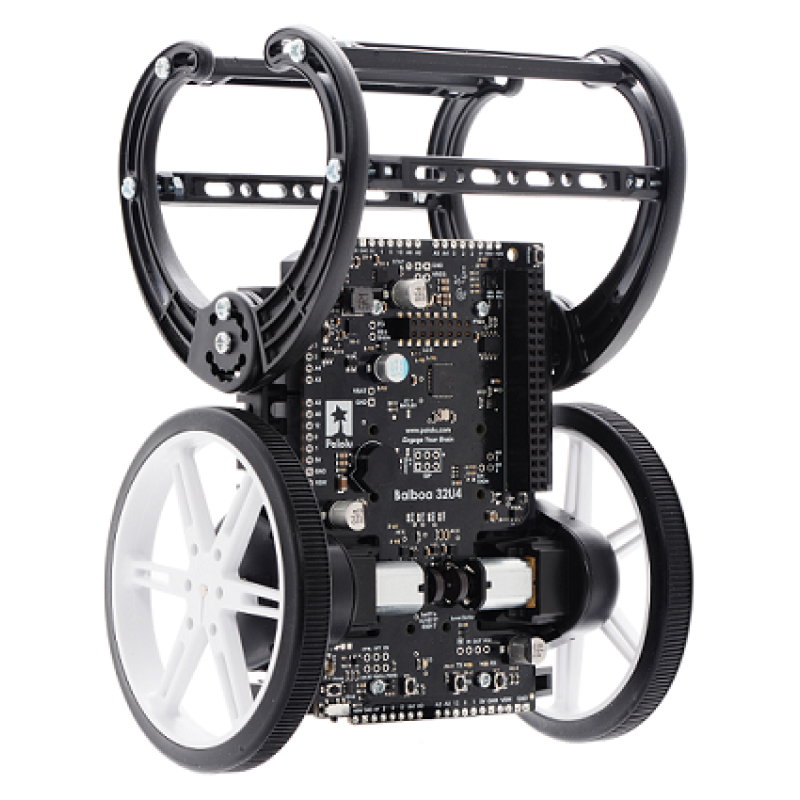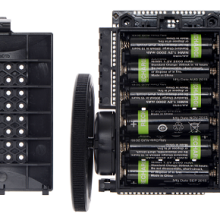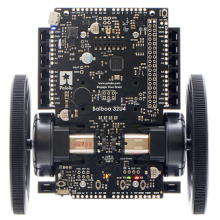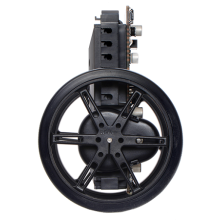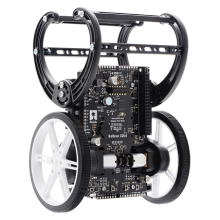Balboa 32U4 Balancing Robot Kit (No Motors or Wheels)
The Balboa 32U4 is a small, user-programmable balancing robot based on the Arduino-compatible ATmega32U4 AVR microcontroller from Microchip (formerly Atmel) and featuring two H-bridge motor drivers, quadrature encoders for closed-loop motor control, a full inertial measurement unit (3-axis accelerometer, gyro, and magnetometer) for estimating orientation and balancing, and an optional interface for connecting a Raspberry Pi to make a Raspberry Pi-controlled balancing robot. The control board includes a powerful 5V switching step-down regulator that can supply up to 2A continuously, along with a versatile power-switching and distribution circuit. Three on-board pushbuttons offer a convenient interface for user input, while indicator LEDs, a buzzer, and a connector for an optional LCD (not included) allow the robot to provide feedback.
This is a kit; assembly (including soldering) is required. Motors and wheels are not included so you can choose your own to personalize your robot; see below for details. Balboa runs on six AA batteries (not included), and a USB A to Micro-B cable (not included) is required for programming.

Like our Zumo 32U4 robot and A-Star 32U4 programmable controllers, which are based on the same microcontroller, Balboa 32U4 features a USB interface and ships preloaded with an Arduino-compatible bootloader. A software add-on is available that makes it easy to program the robot from the Arduino environment, and we have Arduino libraries and example sketches to help get you started. A USB A to Micro-B cable (not included) is required for programming. For those who want to customize or enhance their robots with additional peripherals, the robot’s power rails and microcontroller’s I/O lines can be accessed via 0.1″-spaced through-holes along the sides, front/top, and back/bottom of the control board.
The Balboa 32U4 control board can serve as the robot’s main controller, or it can act a base for a more powerful Raspberry Pi controller. With the addition of a 2×20 female header and standoffs (neither of which are included), a compatible Raspberry Pi (Model B+ or newer, including Pi3 Model B+ and ModelA+) can plug directly into the board. Integrated level shifters make it easy to set up I²C communication and interface other signals between the two controllers, and the control board automatically supplies 5V power to an attached Raspberry Pi. In this setup, the Raspberry Pi can handle the high-level robot control while relying on the Balboa’s ATmega32U4 microcontroller for low-level tasks, like running motors, reading encoders, and interfacing with other analog or timing-sensitive devices.
For those who want to operate the Balboa as a traditional differential-drive robot oriented on its side, a Stability Conversion Kit is available separately. This accessory snaps onto the front end of the Balboa chassis to make it longer and holds an included ball caster, providing a low-friction third contact point. This add-on is also useful in balancing applications, where the ball caster can be left off and the extension piece can be used to make the Balboa taller and give it more mounting points. For those who want to supply their own electronics, see the Balboa Chassis with Stability Conversion Kit.
Dimensions
| Size: | 118 × 112 × 80 mm1 |
|---|---|
| Weight: | 200 g2 |
Notes:
- Of assembled robot with 80×10mm wheels (not including bumper cage, which can be installed in a variety of orientations).
- Of assembled robot as shown in the main product picture, with motors, 80×10mm wheels, and bumper cage. This weight does not include batteries.
Documentation and other information
User’s manual for the Pololu Balboa 32U4 balancing robot.
File downloads
- Pololu A-Star 32U4 drivers for Windows (version 1.3.0.0) (7k zip)
- This download contains the Windows drivers for the A-Star 32U4 and the rest of our 32U4 family of boards.
- Schematic diagram of the Balboa 32U4 control board (587k pdf)
- Pinout and power distribution diagrams of the Balboa 32U4 control board (2MB pdf)
- Gear ratio chart for the Balboa Chassis (447k pdf)
- This printable 1:1 scale chart helps you identify the gears included in the Balboa 32U4 Robot Kit and Balboa Chassis Kit and details the available gear ratios.
- Dimension diagram of the Balboa 32U4 Control Board (471k pdf)
- Dimension diagram for the Balboa 32U4 Balancing Robot Kit (734k pdf)
- Dimension diagram of the Bumper Cage Kit for Balboa 32U4 Balancing Robot (152k pdf)
- Balboa Bumper Cage assembly reference diagram (2MB pdf)
- Note: all angles shown assume the use of 80mm wheels.
- 3D model of the assembled Balboa Balancing Robot (24MB step)
- Note: this model includes micro metal gearmotors and 80mm wheels that are sold separately from the Balboa 32U4 Balancing Robot Kit. This model uses a simplified model of the Balboa 32U4 Control Board to reduce the file size.
- 3D model of the Balboa 32U4 Control Board (27MB step)
- Note: this model includes an LCD and headers that are sold separately from the Balboa 32U4 Balancing Robot Kit.
- Drill guide for the Balboa 32U4 Control Board (285k dxf)
- This DXF drawing shows the locations of all of the board’s holes.
- LSM6DS33 datasheet (1MB pdf)
- Datasheet for the ST LSM6DS33 3D accelerometer and 3D gyroscope.
- LIS3MDL datasheet (2MB pdf)
- Datasheet for the ST LIS3MDL 3-axis magnetometer.
Recommended links
- Balboa 32U4 Arduino library
- The Balboa32U4 library for the Arduino IDE helps interface with the on-board hardware on the Balboa 32U4 control board.
- Balboa 32U4 library documentation
- LSM6 library for Arduino
- An Arduino library for interfacing with the LSM6DS33 accelerometer and gyro.
- LIS3MDL library for Arduino
- An Arduino library for interfacing with the LIS3MDL magnetometer.
- Forum post: Correcting the Balboa magnetometer
- Pololu forum user Jim Remington has shared a technique for compensating for hard iron distortion of the Balboa’s magnetometer. After corrections, he was able to create a compass program with a basic accuracy of ±2°, sufficient for navigating the Balboa around the room.
- Arduino Software
- Arduino integrated development environment (IDE) software
- minimu9-ahrs software for Raspberry Pi
- This is a program for reading sensor data from Pololu IMU boards over I²C. It was written for and tested on the Raspberry Pi, but it will probably also work on similar embedded Linux boards that support I²C.
- Beefy arms for Balboa
- These 3D-printable support arms for the Balboa robot are a fun add-on that can help protect the robot’s electronics from damage if it falls over or runs into an obstacle.
- A-Star repository on GitHub
- This repository contains Arduino add-on files, Windows drivers, and bootloaders for the A-Star 328PB, A-Star 32U4, and the rest of our 32U4 family of boards.
- ATmega32U4 documentation
- Microchip’s product page for the ATmega32U4 AVR microcontroller, with links to its datasheet, application notes, and other resources.

